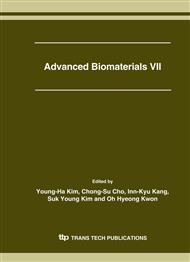p.317
p.321
p.325
p.329
p.333
p.337
p.341
p.345
p.349
Optimization of Scaffold for a Successful Hydrogel-Seeding Method for Vascular Tissue Engineering
Abstract:
Porosity and pore size are needed for successful cell seeding and proliferation into porous scaffolds. This study was focused on a hydrogel-seeding method to improve cell adhesion and proliferation in tubular porous scaffolds for vascular grafts application. Tubular scaffolds were fabricated from a biodegradable elastic polymer, poly(L-lactide-co-ε-caprolactone) (PLCL) (50:50, Mn 1.58×105), by an extrusion-particulate leaching method. Vascular smooth muscle cells (VSMCs) were dispersed in collagen hydrogel and then seeded into the tubular PLCL scaffolds having various pore sizes, 50-100 μm, 100-200 μm, and 300-500 μm, respectively. As a result, the efficiency of cell adhesion and proliferation was dependent on the pore size of the scaffolds. Especially, the cell proliferation efficiency was improved by using the hydrogel-seeding method as compared with by using a previously established method. In summary, this study demonstrates that the efficiency of cell adhesion and proliferation was dependent on the pore size of the scaffolds in the hydrogel-seeding method.
Info:
Periodical:
Pages:
333-336
Citation:
Online since:
July 2007
Authors:
Keywords:
Price:
Сopyright:
© 2007 Trans Tech Publications Ltd. All Rights Reserved
Share:
Citation:


